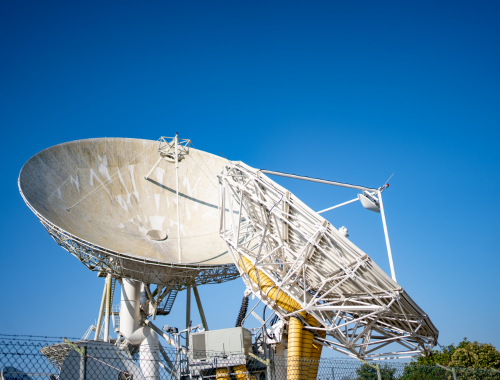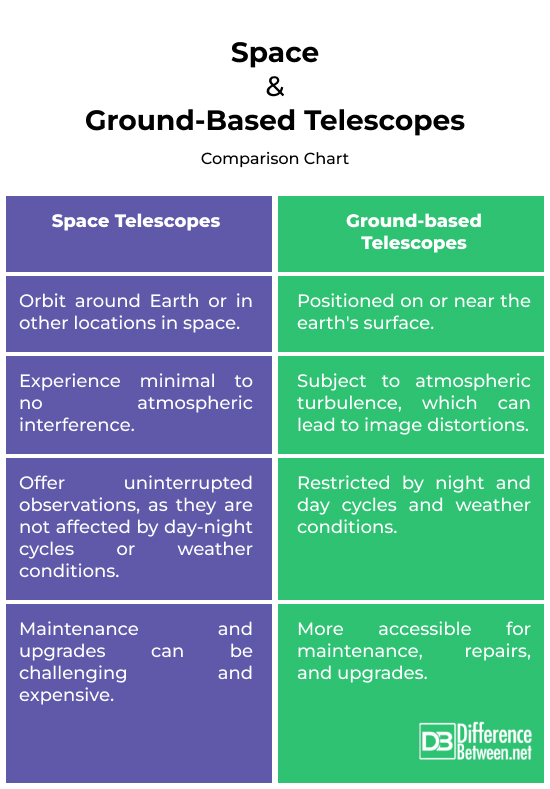Difference Between Space Telescopes and Ground Based Telescopes
In the vast cosmos that surrounds our beautiful planet, the thirst for exploration and understanding has driven humanity to new frontiers. Space exploration has been at the forefront of this quest for knowledge. At the heart of this journey are telescopes, the powerful instruments that have expanded our vision beyond imagination.
Telescopes have played a pivotal role in unraveling the enigma of the cosmos. They serve as our windows to the heavens, allowing us to peer deep into the universe and unlock its secrets. Yet, there are two distinct categories of these marvels of science: the space telescopes and the ground-based telescopes.
In this article, we will delve deeper into the specific differences between space and ground-based telescopes.

What is a Space Telescope?
Space telescopes are sophisticated astronomical observatories placed in orbit around the Earth or positioned at other locations in space. These telescopes are designed to capture and study light and other forms of electromagnetic radiation from celestial objects, free from the interference of Earth’s atmosphere. One of the primary advantages of space telescopes is their ability to bypass Earth’s turbulent atmosphere.
Some popular space telescopes include the Hubble Space Telescope, the James Webb Space Telescope (scheduled for launch), the Chandra X-ray Observatory, and the Spitzer Space Telescope. These telescopes have made groundbreaking discoveries and provided stunning images of the universe, contributing significantly to our understanding of space and celestial objects.

What is a Ground-based Telescope?
Ground-based telescopes are astronomical observatories located on or near the Earth’s surface, as opposed to telescopes placed in space. These telescopes are positioned on mountaintops, remote observatories, or other suitable locations to observe and study celestial objects and phenomena. They are firmly anchored to the ground and do not operate in the vacuum of space.
They can be equipped with instruments to observe various wavelengths, including visible light, radio waves, and some infrared and ultraviolet ranges. They operate on a schedule determined by night and day cycles as well as weather conditions. Some observatories have specific windows of time during which observations can be made, while others can be used year-round.
Well-known ground-based telescopes include the Gran Telescopio Canarias located at the Roque de los Muchachos Observatory in the Canary Islands, the Keck Observatory in Hawaii, the Extremely Large Telescope (ELT) in Chile, and the 500-Meter Aperture Spherical Telescope (FAST) in China.
Difference between Space Telescopes and Ground-Based Telescopes
Atmospheric Interference
Space telescopes are located above Earth’s atmosphere, eliminating atmospheric interference. This allows for sharper and clearer observations of celestial objects. Ground-based telescopes are subject to atmospheric turbulence, which can distort and limit the quality of observations, particularly in the visible and near-infrared wavelengths.
Continuous Observations
Space telescopes can provide uninterrupted observations, unaffected by day-night cycles or weather conditions. This is particularly valuable for studying transient astronomical events and phenomena. Ground-based telescopes are restricted by night and day cycles, as well as weather conditions, which can limit their observation time.
Maintenance and Upgrades
Maintenance and upgrades for space telescopes are challenging and costly, often requiring complex space missions. Ground-based telescopes are more accessible for maintenance, repairs, and instrument upgrades, as they can be reached without space missions.
Wavelength Range
Space telescopes can observe a wide range of wavelengths, including visible, ultraviolet, and infrared, with minimal interference from Earth’s atmosphere. Ground-based telescopes can observe a variety of wavelengths, but some, like X-rays and certain portions of the infrared and ultraviolet spectrum, are limited or absorbed by the atmosphere.
Space vs. Ground-based Telescopes: Comparison Chart

Summary
Space telescopes, located in orbit or space, offer unobstructed views of celestial objects, free from atmospheric interference. They enable continuous, high-quality observations across various wavelengths, making them particularly valuable for studying transient events. In contrast, ground-based telescopes, situated on Earth’s surface, contend with atmospheric turbulence, leading to image distortions, and are constrained by day-night cycles and weather conditions. However, they are more accessible for maintenance and offer a range of observing wavelengths.
FAQs
Why are space telescopes used rather than ground-based telescopes?
Space telescopes are preferred because they operate above Earth’s atmosphere, which eliminates atmospheric interference that can distort observations made by ground-based telescopes. This allows space telescopes to provide clearer, high-quality images and data, making them essential for studying the universe.
What advantages do space telescopes have over traditional ground-based telescopes?
Space telescopes offer several advantages, including uninterrupted observations, access to wavelengths not observable from Earth, and the ability to study celestial objects without atmospheric distortion.
What does a ground-based telescope do?
Ground-based telescopes are positioned on or near Earth’s surface and observe celestial objects and phenomena. They contribute to astronomy by providing access to a range of observing wavelengths and being more accessible for maintenance and upgrades.
Why do we need both space and ground-based telescopes?
Both space and ground-based telescopes complement each other. Space telescopes overcome atmospheric interference and offer continuous observations, while ground-based telescopes are more accessible for maintenance and operate across various wavelengths. Together, they provide a comprehensive view of the universe.
What are the disadvantages of space-based telescopes?
The disadvantages of space-based telescopes include high maintenance and operational costs. They are also less accessible for maintenance and upgrades, often requiring complex and costly space missions for servicing.
What are the disadvantages of a ground-based telescope? How does the space telescope help us overcome these disadvantages?
Ground-based telescopes are limited by atmospheric turbulence and are restricted by night and day cycles, as well as weather conditions. Space telescopes overcome these disadvantages by providing unobstructed observations, continuous monitoring, and the ability to access wavelengths not observable from Earth. However, they come with higher operational and maintenance costs.
- Difference Between Caucus and Primary - June 18, 2024
- Difference Between PPO and POS - May 30, 2024
- Difference Between RFID and NFC - May 28, 2024
Search DifferenceBetween.net :
Leave a Response
References :
[0]Christensen, Lars Lindberg, and Robert A. Fosbury. Hubble: 15 Years of Discovery. Springer Science and Business Media, 2006.
[1]New Worlds, New Horizons in Astronomy and Astrophysics. National Academies Press, 2011.
[2]English, Neil. Space Telescopes: Capturing the Rays of the Electromagnetic Spectrum. Springer, 2016.
[3]Langley, Andrew. Space Telescopes. Raintree, 2021.
[4]Image credit: https://www.canva.com/photos/MAFXLIP6L-8-earth-based-astronomical-radio-telescope/
[5]Image credit: https://www.canva.com/photos/MAE1gX0BXe8-james-webb-space-telescope-in-space-elements-of-this-image-furnished-by-nasa-3d-rendering-/
